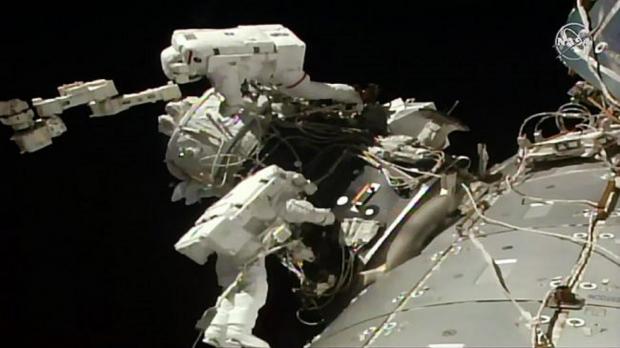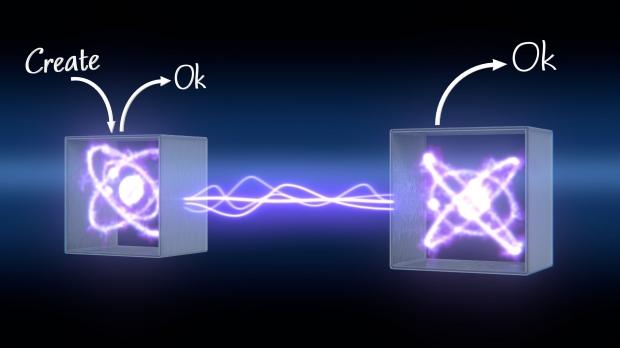Science, Space, Health & Robotics News - Page 390
KFC debuts test of non-meat 'miracle' nuggets in Atlanta, Georgia
Kentucky Fried Chicken has just unveiled something I don't think anyone would've predicted when the colonel began his world domination through the secret herbs and spices in 1952 -- meat-free nuggets.
The company is using Beyond Meat, which are plant-based fake meat nuggets -- with KFC testing out the new 'Kentucky Fried Miracle' in Atlanta, Georgia. The thing is that plant-based meat alternatives aren't anything new, but Kentucky Fried Chicken throwing its hat into the ring is a big deal with other giants in Burger King, Carl's Jr, and Del Taco all offering plant-based meats from either Beyond Meats, or their competitor Impossible Foods.
KFC will cook the fake meat in the same fryers used to cook the normal chicken, so it is not absolutely, completely meat-free. It's being cooked in the same oil as the meat, so I guess there will be some form of chicken floating onto the plant-based meat... right?
Continue reading: KFC debuts test of non-meat 'miracle' nuggets in Atlanta, Georgia (full post)
Sex robots with 'coding errors' could STRANGLE you in the act
The world is getting pretty kinky, but I think this new story really tops them all - killer robots that will strangle their partners, is something that is being warned if robotics are not regulated properly.
Doll collector Brick Dollbanger is an "expert" on sex robots, who has warned that a "coding error" could turn your robotic girlfriend into a killer, strangling you in the act. Dollbanger works with sex robot manufacturers Realbotix and Abyss, where he warned: "It scares me to death, it's a machine and it's always going to be a machine".
I didn't quite believe this story when I first read it, so I slid into the world of this Brick Dollbanger, the doll banger. Forbes wrote a piece with a lot of girth on the doll banger in September 2018, referring to him as a "sex robot beta-tester" in an article titled Meet The Man Who Test Drives Sex Robots. So yeah, it's real.
Continue reading: Sex robots with 'coding errors' could STRANGLE you in the act (full post)
NASA to host Reddit 'Ask Me Anything!' Aug 26th, Flat Earthers rally
NASA will be hosting a Reddit 'Ask Me Anything' (AMA) in a couple of days, this will no doubt spark Flat Earthers rallying to the Reddit board with numerous questions.
If you haven't heard about Reddit 'Ask Me Anything's then you have truly missed out on some of the greatest internet information harvesting events. The 'Ask Me Anything' sub-reddit is one of the most subscribed to Reddits on the platform as celebrities, high-profile businessmen, scientists, influencers and people alike take to the platform to answer community voted questions.
The people that are doing the 'Ask Me Anything' provide credible information for who they claim to be and proceed to answer any which question the community has provided them at their discretion. While you might think that they could go south since its the internet, and the internet can certainly be like the Wild Wild West, these events have actually provided some quite valuable information.
Continue reading: NASA to host Reddit 'Ask Me Anything!' Aug 26th, Flat Earthers rally (full post)
President Trump wants to NUKE HURRICANES to stop them hitting the US
I don't know what would scare me more, seeing a hurricane off in the distance -- or a stealth bomber flying over it and dropping a nuclear bomb inside of it. Yeah, that's what President Trump wants to do.
Axios reports from sources who have heard the president's private remarks and been briefed on a National Security Council memorandum that recorded those comments "that in a meeting between President Trump and top national security and homeland security officials over threats with hurricanes, Trump said: "I got it. I got it. Why don't we nuke them?"
Trump continued: "They start forming off the coast of Africa, as they're moving across the Atlantic, we drop a bomb inside the eye of the hurricane and it disrupts it. Why can't we do that?"
Continue reading: President Trump wants to NUKE HURRICANES to stop them hitting the US (full post)
NASA investigating first SPACE CRIME, as astronaut is naughty on ISS
NASA is in the middle of investigating its first space crime, with American astronaut Anne McClain accessing her partners bank account... from the International Space Station. This could be the first ever crime committed in the silence of space.
McClain is now back on solid ground back here on Earth, where according to her lawyer who spoke with The New York Times, she was only accessing her partners bank account to make sure their family's finances were OK. She wanted to make sure there was enough money to pay for the usual bills, and to care for their son.
Her lawyer added: "She strenuously denies that she did anything improper" and added that she was "totally cooperating".
Continue reading: NASA investigating first SPACE CRIME, as astronaut is naughty on ISS (full post)
Some exoplanets could be better suited to harbor life than Earth
Astronomers are constantly searching for life elsewhere in the universe and everyday we move closer to answering that big question - are we alone out here?
Scientists have presented new work at the Keynote Lecture at the Goldschmidt Geochemistry Congress in Barcelona, claiming that they have located several exoplanets that have the required conditions to harbor life. So does an exoplanet need to harbor life? Firstly, scientists and astronomers are looking for planets that come under the 'habitable zone', which means the planet must have a potential for liquid water oceans and possibly breathable oxygen.
Dr. Stephanie Olson (University of Chicago) presented this new information and says that "NASA's search for life in the Universe is focused on so-called 'habitable zone' planets, which are worlds that have the potential for liquid water oceans. But not all oceans are equally hospitable-and some oceans will be better places to live than others due to their global circulation patterns."
Continue reading: Some exoplanets could be better suited to harbor life than Earth (full post)
ISS Astronauts pave paradise and put up a parking spot for spacecrafts
Two NASA astronauts have taken a leap outside the International Space Station and begun a walk to install a brand new loading bay for future visiting space crafts.
The walk lasted for 6 hours and 32 minutes and astronauts Nick Hague and Andrew Morgan worked together to install the International Docking Adapter-3 (IDA-3) to the space facing side of the station. This successful installation will serve as a literal parking spot for future NASA, SpaceX and Boeing spacecrafts.
This marked the first time Morgan has ventured out into the infinite abyss via a spacewalk, and according to Mike Barratt, spacecraft communicator in Mission Control, "Welcome to the club, you did a brilliant job." The ISS crew aboard is currently doing experiments and stem cell differentiation in a zero gravity environment. With this hopeful new found knowledge, NASA, SpaceX and Boeing believe this information will be able to assist the human-race level push to land on Mars.
Continue reading: ISS Astronauts pave paradise and put up a parking spot for spacecrafts (full post)
3 Earth-sized planets found, only 12 light-years away & possible water
Astronomers have located three Earth-sized planets which are orbiting a neighboring star that is about 12 light-years away.
The scientists estimate that all three of the discovered planets are to be at least 1.4 to 1.8 times the mass of Earth, and that they orbit their star every three to 13 days. To give a digestable example of how short this is, in our solar system, Mercury has the shortest orbit of our Sun at just 88 days. The most interesting part of this three planet discovery is the planet that has been titled as 'planet d', scientists are most interested in this planet because it falls within the star's habitable zone with the possible chance of water existing on the surface.
Ignasi Ribas, a co-author on the new paper and a researcher at the Institute of Space Sciences in Barcelona, Spain said "We are now one step closer [to] getting a census of rocky planets in the solar neighborhood". It is extremely difficult to determine if 'planet d' harbors the requirements for life to exist, as scientists need to account for the past of the star its orbiting. It could be possible that the star has ejected large amount of radiation at 'planet d', essentially ruining any possible chance of the planet having a habitable atmosphere.
Continue reading: 3 Earth-sized planets found, only 12 light-years away & possible water (full post)
World's first real-world quantum network built with brand new protocol
A team of researchers have made a break-through discovery in quantum internet networking, announcing they have developed the first quantum internet protocol.
To understand the achievement that has been made here you must first understand current internet protocols. In classical computing and everyday use of the internet, a collection of software layers which are reffered to as a network stack enables devices to communicate with eachother, an example of this is HTTP. Professor Stephanie Wehner from the research team QuTech describes this by saying "All of us use classical link layer protocols in everyday life. One example is Wi-Fi, which allows an unreliable radio signal-suffering from interruptions and interference-to be used to transmit data reliably between compatible devices."
Quantum networking uses the same premise as traditional computing, but is still very different. Due to the differences between classical computing and quantum, the team developed a new "quantum network stack" that is the "world's first link-layer protocol". Since a quantum network uses quantum bits, or qubits to transfer information, a new network protocol had to be developed due to quantum bits not retaining data reliably. This newly developed protocol overcomes those hurdles that quantum level software development was encountering.
Continue reading: World's first real-world quantum network built with brand new protocol (full post)
Scientists on brink of making & commercializing pollution free energy
While wide-spread pollution free energy might sound like pipe dream when thinking about how many facets of the world economy uses fossil fuels, we might not actually be that far away from it.
A Canadian group of engineers recently published a new paper detailing a method humans could extract hydrogen from oil sands and fields. This new method could enable a large-scale adoption that would ultimately cause a domino effect into energy market, making it extremely cheap to capture hydrogen instead of expensive. The researchers inject oxygen into the oil fields which then raises the temperature and liberates the hydrogen, filters are then used to separate the hydrogen from the other gases that are present.
The commercialization of this new method is already taking place and, Grant Strem, CEO of Proton Technologies has given a statement regarding the discovery "This technique can draw up huge quantities of hydrogen while leaving the carbon in the ground. When working at production level, we anticipate we will be able to use the existing infrastructure and distribution chains to produce H2 for between 10 and 50 cents per kilo. This means it potentially costs a fraction of gasoline for equivalent output".
Continue reading: Scientists on brink of making & commercializing pollution free energy (full post)











